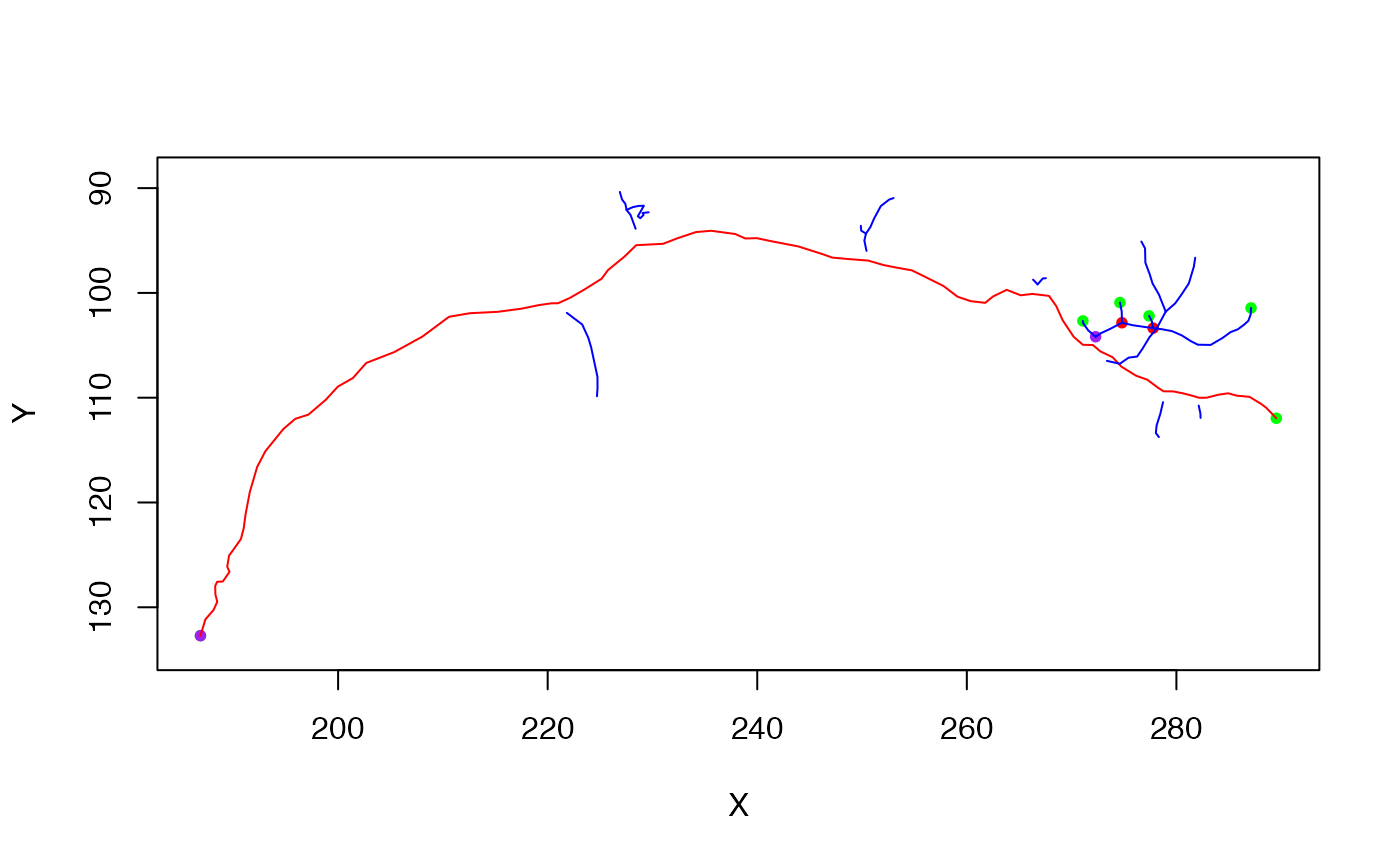the ngraph class contains a (completely general) graph
representation of a neuron's connectivity in an igraph object. It
may additionally contain vertex name or position data. See Connectivity
section.
ngraph() creates an ngraph from edge and vertex information.
as.ngraph converts an object to an ngraph
as.ngraph.dataframe construct ngraph from a data.frame
containing SWC format data
as.ngraph.neuron construct ngraph from a neuron
ngraph(
el,
vertexnames,
xyz = NULL,
diam = NULL,
directed = TRUE,
weights = FALSE,
vertex.attributes = NULL,
graph.attributes = NULL
)
as.ngraph(x, ...)
# S3 method for data.frame
as.ngraph(x, directed = TRUE, ...)
# S3 method for neuron
as.ngraph(x, directed = TRUE, method = c("swc", "seglist"), ...)Arguments
- el
A two column matrix (start, end) defining edges.
startmeans closer to the root (soma) of the neuron.- vertexnames
Integer names for graph nodes - the edge list is specified using these names (see details).
- xyz
3D coordinates of vertices (optional, Nx3 matrix, or Nx4 matrix when 4th column is assumed to be diameter)
- diam
Diameter of neuron at each vertex (optional)
- directed
Whether the resultant graph should be directed (default TRUE)
- weights
Logical value indicating whether edge weights defined by the 3D distance between points should be added to graph (default
FALSE) or a numeric vector of weights.- vertex.attributes, graph.attributes
List of named attributes to be added to the graph. The elements of
vertex.attributesmust be vectors whose length is compatible with the number of elements in the graph. Seeset.vertex.attributefor details.- x
Object to convert (see method descriptions)
- ...
Arguments passed to methods
- method
Whether to use the swc data (x$d) or the seglist to define neuronal connectivity to generate graph.
Value
an igraph object with additional class ngraph, having a
vertex for each entry in vertexnames, each vertex having a label attribute. All vertices are included whether connected or not.
Details
Note that the as.ngraph.neuron method always keeps the
original vertex names (a.k.a. PointNo) as read in from the original file.
Connectivity
We make the following assumptions about neurons coming in
They have an integer vertex name that need not start from 1 and that may have gaps. This is analogous to the PointNo field of the core data block of
neuronobjects.The edge list that defines connectivity specifies those edges using pairs of vertex names, _not_ raw vertex indices.
We make no attempt to determine the root points at this stage.
The raw vertex ids in the graph will be in the order of vertexnames and can
therefore be used to index a block of vertex coordinates. The vertexnames
will be stored using the vertex attribute name. The underlying
igraph class allows nodes to be specified by their name. This provides a
convenient way to define nodes in an ngraph object by the numeric
identifier encoded by the PointNo field of the corresponding
neuron.
When the graph is directed (default) the edges will be from the root to the other tips of the neuron.
Morphology
The morphology of the neuron is encoded by the combination of connectivity information (i.e. the graph) and spatial data encoded as the 3D position and diameter of each vertex. Position information is stored as vertex attributes X, Y, and Z.
See also
igraph, set.vertex.attribute,
subset.neuron for example of graph-based manipulation of a
neuron, plot3d.ngraph
Other neuron:
neuron(),
plot.dotprops(),
potential_synapses(),
prune(),
resample(),
rootpoints(),
spine(),
subset.neuron()
Examples
n=Cell07PNs[[1]]
g=as.ngraph(n)
library(igraph)
#>
#> Attaching package: ‘igraph’
#> The following object is masked from ‘package:nat’:
#>
#> union
#> The following object is masked from ‘package:testthat’:
#>
#> compare
#> The following objects are masked from ‘package:stats’:
#>
#> decompose, spectrum
#> The following object is masked from ‘package:base’:
#>
#> union
# check that vertex attributes of graph match X position
all.equal(V(g)$X, n$d$X)
#> [1] TRUE
# Use 3D segment lengths as edge length of graph
gw=as.ngraph(n, weights=TRUE)
# find longest path across graph
d=get.diameter(gw)
# make a new neuron using the longest path
gw_spine=as.neuron(induced.subgraph(gw, d))
# make a new neuron containing all nodes except those in longest path
gw_antispine=as.neuron(delete.vertices(gw, d))
# note use of bounding box of original neuron to set plot axes
plot(gw_spine, col='red', boundingbox=boundingbox(n))
plot(gw_antispine, col='blue', add=TRUE)
